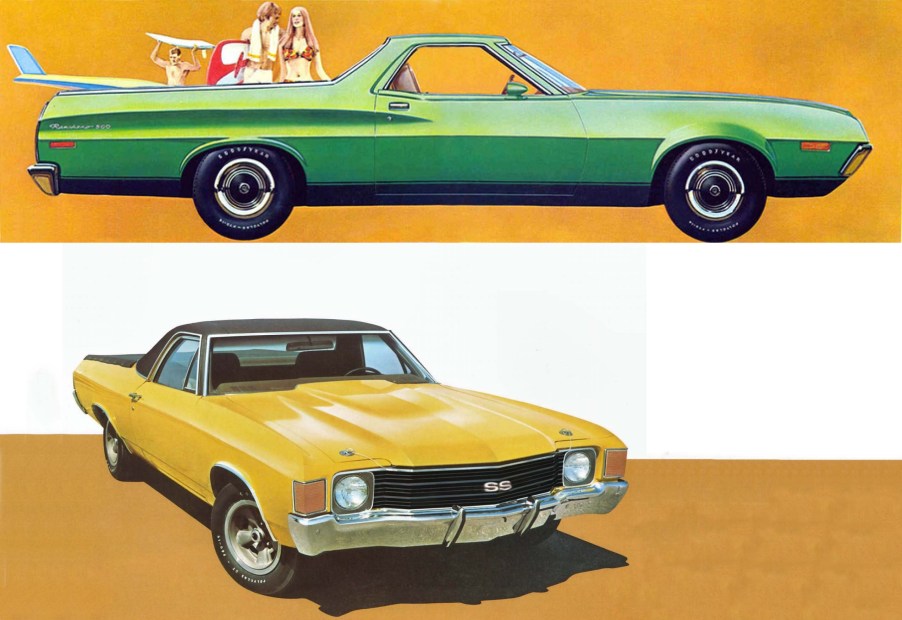
1972 Chevy El Camino Vs. Ford Ranchero
Muscle car madness reached its peak in about 1970 but the aftereffects were still burning bright in 1972. It was a pivotal year for the car/truck platform known as El Camino for Chevrolet, and Ranchero for Ford. It was the last year of arguably the best series of El Camino, and the first year of Ford’s all-new Torino-based Ranchero. So it’s Ranchero vs El Camino.
Both had been developed in the heyday of the muscle car when raw performance and bigger numbers laid precedence over road manners and common sense. That’s what made it so glorious. It was but a moment before corporate responsibility and insurance and gasoline company greediness combusted resulting in cars like the Mustang II and Chevy Sprint.

Ford was the first to come up with the car/truck for America in 1957. Especially in those days when trucks were for hauling manure or supplies to job sites, a vehicle without this stigma that carried the style of full-size sedans made sense. Chevy followed up two years later with the El Camino. It, too, was based on Chevy’s full-size sedan.
Both El Camino And Ranchero Become Midsize
While Ford shifted gears in 1960 and moved the Ranchero platform to its compact Falcon, Chevy opted out until 1964. That’s when the midsize Chevelle came out, and along with it the El Camino it was based on. By 1966, Ford also switched platforms for the Ranchero to its midsize Fairlane. This was the sweet spot for both companies and each of their car/truck variants would stick with this segment until the end.

The midsize platform was chosen by all of the manufacturers as the de facto muscle car for its largest displacement engines with the most horsepower, along with each one’s pony cars and the Corvette. Every option available on either a Chevelle or Torino could be had with its El Camino or Ranchero counterpart. By 1972 this meant some of the largest and most powerful cars ever offered by Detroit, until the advent of the modern muscle car.
1972 Ford Ranchero
The Ranchero’s largest was the 429 ci with 212 hp. which was offered through 1973. Either the C6 automatic or four-speed manual could be ordered. The 351 ci Cobra Jet GT was also available through 1974. One of the biggest advantages of the new Ranchero was reverting back to the body-on-frame. Front disc brakes were standard. The government-mandated five-mph bumpers required a different front end in 1973, so the 1972 Ranchero is a one-year-only design. Many prefer it to the later 1973-1975 versions.
1972 Chevy El Camino

Chevy’s El Camino would be all-new in 1973, so in many ways, 1972 was the end of an era. The platform came out with restyled Chevelles in 1968, lasting through 1972. Many consider the 1972 to be the best-looking of the five years. Again, the largest-displacement engines could be found in El Caminos, including the LS5 454 ci big block with 270 hp and 390 lb-ft of torque. This appeared to be a much lower horsepower rating until you know that the government-mandated all net horsepower figures include testing with all accessories and emission controls. By 1973 the all-new El Camino was larger, heavier, and available with less horsepower and five mph bumpers. Performance was downplayed, and the muscle car era was over. So 1972 is a special year for muscle cars and the El Camino.
El Camino Vs. Ranchero
So which one wins? Either one. It depends on your preferences for styling, marques, and whether you like the first or last of something. The El Camino sold over 20,000 more examples than the Ranchero in 1972. But the Ranchero was a huge hit in comparison to previous models, which for years sold in the 18,000-24,000 range. In 1972 it sold over 40,000.

The El Camino sold over 63,000 vehicles, topping the previous four years which hovered around 42,000-45,000. Surprisingly, the 1973 El Camino sold over 71,000 before dropping to 56,000 in 1974, 36,000 in 1975, 50,000 in 1976, and ending this body style with over 60,000 in 1977.
There are many iterations of both with the SS being the top model for El Camino and the GT the top of the Ranchero line. They’re both great-looking, great-performing one-half-ton trucks. You just can’t go wrong with either.




